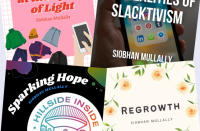COMBING THROUGH scientific studies and correspondents’ reports in her seaside home in Maine, Rachel Carson saw nature bludgeoned by a chemical barrage. Telling stories about the northern Barren Lands, Farley Mowat expressed the spirit and meaning of wolves at home in the wilderness. Drawing on advice from every continent, Barbara Ward and René Dubos crafted an early vision of a shared planet. Elsewhere, computer modelers projected a collision between growing human appetites and a finite world.
COMBING THROUGH scientific studies and correspondents’ reports in her seaside home in Maine, Rachel Carson saw nature bludgeoned by a chemical barrage. Telling stories about the northern Barren Lands, Farley Mowat expressed the spirit and meaning of wolves at home in the wilderness. Drawing on advice from every continent, Barbara Ward and René Dubos crafted an early vision of a shared planet. Elsewhere, computer modelers projected a collision between growing human appetites and a finite world. The books that resulted – Silent Spring, Never Cry Wolf, Only One The Limits to Growth – conveyed both sound information and enduring environmental themes. They accomplished their work in the world.
That books set the environmental agenda may be debated, but they certainly record its evolution. Obscure at first, Aldo Leopold’s A Sand County Almanac (published in 1949) presented a principled critique of resource management that soon inspired concerns about transforming forests and other ecosystems into commodities. By 1960, writers were identifying other issues. Nuclear fallout was in the wind, and chemical contaminants were turning up even in Antarctica. In Silent Spring (1962), Carson not only described the problem, she also captured a wider unease regarding the consequences of modern industry. Carson was not alone. Robert Rudd, in Pesticides and the Living Landscape (1964), and England’s Kenneth Mellanby, with Pesticides and Pollution (1967), amassed information about DDT and other toxic substances, and critiqued the ideologies of control over nature that they epitomized.
By the late 1960s, anxieties about local and global environments extended beyond contaminants. As Max Nicholson suggested in The Environmental Revolution (1970), followed the next year by Barry Commoner’s The Closing Circle a more thorough critique of industrial society seemed to be in order. While some argued that the problem was mainly a matter of numbers, these books kick-started a debate that continues today. Long before any notion of ecological footprints, authors were presenting grim visions of the consequences of population growth and resource scarcity. William Vogt’s Road to Survival (1948) mapped a postwar Malthusian landscape, Paul Ehrlich’s The Population 1968) warned of famine and Erik Eckholm’s Losing 1976) described the erosion of overworked soils.
By the 1980s, with some of the more obvious forms of pollution coming under control (at least in wealthier countries), Theo Colborn and her colleagues warned of trace contaminants, including endocrine disruptors, in Our Stolen Future (1986), a book they described as an updated Silent Spring. Recently, authors have lined up alongside Al Gore’s An Inconvenient Truth (2006) to examine climate change. George Monbiot’s Heat (2007), Tim Flannery’s The Weather Makers (2007) and Elizabeth Kolbert’s Field Notes From a Catastrophe (2006) all went beyond the daily debates, examining how scientists study the climate and how the rest of us use and abuse their advice.
Going one step beyond just tracking the environmental agenda, some books have, arguably, defined it. For instance, by calling attention to what is at risk, authors have emphasized what must be preserved. In the 1960s, the Sierra Club pioneered one such approach: amply illustrated, often expensive, always beautiful books portraying the wonder and fragility of wilderness. Since then, every endangered landscape, from Clayoquot Sound to the Oak Ridges Moraine, has (it seems) inspired a coffee-table book. Such efforts are implicitly defensive; they inspire action through visions of what may be lost.
Other authors, in contrast, have sketched what never existed, yet could. These visions are often optimistic, perhaps never more so than when attempting to reconcile economics and the environment. Amory Lovins’ Soft Energy Paths was an early effort. In 1977, it suggested we choose to meet reasonable human needs rather than search endlessly for more energy. Since then, Lovins, with authors like Paul Hawken, in books such as Natural Capitalism (1999), has explained how to transform business to be friendly to both society and the planet. The work of both authors has been essential in communicating environmental priorities to new and powerful constituencies.
Only in books do authors have the space to explore big, complex arguments – especially those that connect distinct worlds of ideas. In 1969, Ian McHarg made some key connections by combining knowledge of ecology and geology with ideas about design. Architects and planners, he insisted, needed to know about natural forces, and conversely, ecologists would do well by learning more about human-dominated landscapes. McHarg’s book, Design with Nature, showed how transforming the planet need not always be destructive; it could open up creative possibilities. His views inspired other books, like Michael Hough’s City Form and Natural Process (1989), as well as countless practical experiments in urban ecology and landscape design.
Such connections have not been restricted to concerns about pollution or endangered habitats. In fact, some of the most essential works have been penned by writers examining matters other than the environment. In 1958, economist John Kenneth Galbraith published The Affluent Society. Examining the triumph of American consumerism amidst crumbling city streets and parks filled with garbage, Galbraith saw an imbalance between private wealth and public poverty. It’s a disequilibrium that, as experiments in deregulation and privatization have subsequently shown, is at the root of many environmental problems. Three years later, in The Death and Life of Great American Cities (1961), Jane Jacobs critiqued the emphasis on order and efficiency in urban planning, and the silencing of communities affected by highways and other projects. Unlike Carson, who was writing Silent Spring at the same time, neither Galbraith nor Jacobs focused on the environment. But by insisting on the need to pay attention to public space and to the value of neighbourhoods, which, like ecosystems, are vulnerable to the imposition of order and tidiness, they identified themes essential to environmental values.
Their impact notwithstanding, books demand caution, and not just because they warn of catastrophe. Some volumes have gained fame by expressing a convenient ideology, while masquerading as objective analysis. In 1980, Julian Resourceful Earth laid the groundwork for Ronald Reagan’s anti-environmental revolution. More recently, Bjørn Lomborg’s The Skeptical Environmentalist (2001) captured conservatives’ hearts by arguing that environmental concerns are exaggerated – a conclusion arrived at only after much torturing of the data.
Lomborg is an extreme case, but it is worth remembering that every book is framed by subjective ideas about how the world works. For example, the spate of Malthusian perspectives on population, like Vogt’s Road to Survival, Ehrlich’s The Population Bomb and Eckholm’s Losing reflected, above all, confidence in the simple arithmetic of growth rates, as well as Cold War anxieties about global stability. Meanwhile, they neglected the institutional and economic forces that shape people’s actual relationships with land and resources.
Books can also give a distorted view of what is really at stake. Many use art and photographs to celebrate environmental wonders, but in emphasizing pristine wilderness, they neglect those places where humans and nature live in harmony. Further, by implying that environmentalists are preoccupied by such “natural” habitats, they ignore other places, such as working class communities located near toxic industries and the fierce struggles for environmental justice that occur in them. Such places are seldom attractive, nor are they places of leisure or otherwise of interest to those who can afford these often expensive coffee-table show pieces.
Thousands of environmental books have appeared over the last half-century, so what separates the classics? Timing counts for something. In No Place to Hide, David Bradley wrote a terrific account warning of the risks of atomic radiation. But this was 1948, and both Cold War fears and the promise of the “peaceful atom” proved more compelling. But books also make their own opportunities. Carson combined her outrage over pesticides with her deep knowledge of ecology, and Jacobs’ views of city planning were grounded in her close observation of how neighbourhoods actually work. Both understood the big issues, but they also knew their birds and their people, and they wrote with passion and eloquence. So did Leopold. His images in A Sand County Almanac of a fierce green fire dying in the eye of a wolf, and of mountains living in fear of deer captured the emotional and practical import of predators and the balance of nature. And in The End of Nature (1989), Bill McKibben demonstrated how wonderful writing can give wings to otherwise grim views of the loss of the wild.
Alternatives also matter. Presenting not only predictions of doom or vague dreams of transformative social change, but doing the hard work of identifying what can be done, and by whom, is vital. In Green: A Citizen’s Guide to Urban Land Protection in Canada (2005) is a terrific example.
As I write this, snow is falling, midway through an unseasonably frigid December. Far away in Bali, the pathway to a post-Kyoto climate is being hammered out. The Europeans are getting serious, the Chinese are insisting on their right to pollute, the Americans are looking bushed and Canada is sliding into embarrassed irrelevance. Ample updates and critiques are instantly available on websites. But just as one December doesn’t make a climate trend, neither is the daily news our only guide to action. It’s by delving into books that we come to understand where we’ve been, where we may be heading and why.
Stephen Bocking, a regular contributor to Alternatives, is professor at and chair of the Environmental and Resource Science/Studies Program at Trent University and author of A\J’s EcoLogic blog.
You can follow Stephen on Twitter at @BockingStephen or read his blog: Environment, History and Science.












